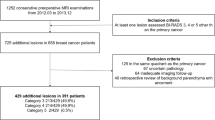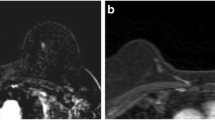Abstract
Objective
The purpose of this study was to analyze the rate of malignancy of synchronous Breast Imaging Reporting and Data System (BI-RADS) category 3 lesions identified by preoperative magnetic resonance imaging (MRI) in patients with breast cancer that were followed up rather than biopsied.
Methods
From electronic medical records, we identified 99 patients treated in our institution for whom preoperative breast MRI identified synchronous BI-RADS 3 lesions. Lesion characteristics, rate of second-look ultrasonography (US), rate of collegial decision-making, and rate of biopsies performed during the period of monitoring were analyzed.
Results
Second-look US was performed in 96 of 99 patients and did not reveal any lesion. Collegial decision-making for follow-up validation was asked in 32%. The median time to last MRI was 24.4 months (interquartile range [IQR] [19.3; 36.3]). The median follow-up was 39 months (IQR [28; 52]). Two cancers were diagnosed, one at 5 months and one at 26 months of follow-up. The incidence of malignancy of followed up synchronous BI-RADS category 3 lesions was 1.0% (95% CI [0.1%; 7.1%]) at 6 months and 2.2% (95% CI [0.6%; 8.6%]) at 30 months.
Conclusion
Monitoring could be proposed for synchronous BI-RADS category 3 lesions detected in preoperative breast cancer patients. A continued follow-up beyond 2 years could be of benefit.
Key Points
• Follow-up can be proposed for MRI BI-RADS category 3 lesions not detected at second-look ultrasound, possibly after a collegial decision.
• Follow-up should be continued annually since cancer may occur beyond 2 years.



Similar content being viewed by others
Abbreviations
- BI-RADS:
-
Breast Imaging Reporting and Data System
- CI:
-
Confidence interval
- ER:
-
Estrogen receptor
- HAS:
-
Haute Autorité de Santé
- HER2:
-
Human epidermal growth factor receptor 2
- IQR:
-
Interquartile range
- MRI:
-
Magnetic Resonance Imaging
- NME:
-
Non-mass enhancement
- PR:
-
Progesterone receptor
- US:
-
Ultrasonography
References
Lafaye-Carré S, Collinet P, Vinatier D et al (2014) Impact de l’IRM mammaire préopératoire sur la prise en charge chirurgicale des cancers du sein : expérience de deux centres hospitaliers universitaires. Gynecol Obstet Fertil. https://doi.org/10.1016/j.gyobfe.2014.07.018
Hartman M, Czene K, Reilly M et al (2007) Incidence and prognosis of synchronous and metachronous bilateral breast cancer. J Clin Oncol 25:4210–4216
Plana MN, Carreira C, Muriel A et al (2012) Magnetic resonance imaging in the preoperative assessment of patients with primary breast cancer: systematic review of diagnostic accuracy and meta-analysis. Eur Radiol 22:26–38
Peters NHGM, Borel Rinkes IHM, Zuithoff NPA, Mali WPTM, Moons KGM, Peeters PHM (2008) Meta-analysis of MR imaging in the diagnosis of breast lesions. Radiology 246:116–124
Medeiros LR, Duarte CS, Rosa DD et al (2011) Accuracy of magnetic resonance in suspicious breast lesions: a systematic quantitative review and meta-analysis. Breast Cancer Res Treat 126:273–285
Bennani-Baiti B, Baltzer PA (2017) MR imaging for diagnosis of malignancy in mammographic microcalcifications: a systematic review and meta-analysis. Radiology 283:692–701
Linda A, Zuiani C, Londero V, Bazzocchi M (2008) Outcome of initially only magnetic resonance mammography-detected findings with and without correlate at second-look sonography: distribution according to patient history of breast cancer and lesion size. Breast 17:51–57
Grimm LJ, Anderson AL, Baker JA et al (2015) Frequency of malignancy and imaging characteristics of probably benign lesions seen at breast MRI. AJR Am J Roentgenol 205:442–447
Chikarmane SA, Birdwell RL, Poole PS, Sippo DA, Giess CS (2016) Characteristics, malignancy rate, and follow-up of BI-RADS category 3 lesions identified at breast MR imaging: implications for MR image interpretation and management. Radiology 280:707–715
Haute Autorité de Santé (2010) Place de l’IRM Mammaire dans le bilan d’extension locorégional préthérapeutique du cancer du sein - Rapport d’évaluation. Haute Autorité de Santé. Available via https://www.has-sante.fr/jcms/c_936419/fr/place-de-l-irm-mammaire-dans-le-bilan-d-extension-locoregional-pretherapeutique-du-cancer-du-sein-rapport-d-evaluation Accessed 7 Jan 2020
Turnbull L, Brown S, Harvey I et al (2010) Comparative effectiveness of MRI in breast cancer (COMICE) trial: a randomised controlled trial. Lancet 375:563–571
Peters NHGM, van Esser S, van den Bosch MAAJ et al (2017) Preoperative MRI and surgical management in patients with nonpalpable breast cancer: the MONET - randomised controlled trial. Eur J Cancer 47:879–886
Houssami N, Ciatto S, Macaskill P et al (2008) Accuracy and surgical impact of magnetic resonance imaging in breast cancer staging: systematic review and meta-analysis in detection of multifocal and multicentric cancer. J Clin Oncol 26:3248–3258
Kim SJ, Ko EY, Shin JH et al (2008) Application of sonographic BI-RADS to synchronous breast nodules detected in patients with breast cancer. AJR Am J Roentgenol 191:653–658
Lee S, Jung Y, Bae Y (2015) Synchronous BI-RADS category 3 lesions on preoperative ultrasonography in patients with breast cancer: is short-term follow-up appropriate? J Breast Cancer 18:181–186
Park SY, Han B-K, Ko ES, Ko EY, Cho EY (2019) Additional lesions seen in magnetic resonance imaging of breast cancer patients: the role of second-look ultrasound and imaging-guided interventions. Ultrasonography 38:76–82
Spick C, Baltzer PAT (2014) Diagnostic utility of second-look US for breast lesions identified at MR imaging: systematic review and meta-analysis. Radiology 273:401–409
Fiaschetti V, Salimbeni C, Gaspari E et al (2012) The role of second-look ultrasound of BIRADS-3 mammary lesions detected by breast MR imaging. Eur J Radiol 81:3178–3184
Abe H, Schmidt RA, Shah RN, Shimauchi A et al (2010) MR-directed (« Second-Look ») ultrasound examination for breast lesions detected initially on MRI: MR and sonographic findings. AJR Am J Roentgenol 194:370–377
Gweon HM, Cho N, Kim S-Y et al (2017) Management for BI-RADS category 3 lesions detected in preoperative breast MR imaging of breast cancer patients. Eur Radiol 27:3211–3216
Funding
The authors state that this work has not received any funding
Author information
Authors and Affiliations
Corresponding author
Ethics declarations
Guarantor
The scientific guarantor of this publication is Philippe HENROT, MD.
Conflict of interest
The authors of this manuscript declare no relationships with any companies whose products or services may be related to the subject matter of the article.
Statistics and biometry
Julia Salleron provided statistical advice for this manuscript.
Ethical approval
This study has been declared to the French National Commission on Information Technology and Liberties (CNIL) on August 12 2019 and has been registered as a CNIL compliance declaration (MR004-2203860) by the Data Protection Officer of the Cancer Institute of Lorraine French Region (Number 2203860). According to the CNIL MR004 compliance declaration, all patients are informed of the potential retrospective use of their clinical data for research purposes and of their right to refuse. In the present study, no refusal was received.
Methodology
• Unicentric
• retrospective
• observational study
Additional information
Publisher’s note
Springer Nature remains neutral with regard to jurisdictional claims in published maps and institutional affiliations.
Supplementary information
ESM 1
eTable 1 in Supplement: MR acquisition parameters. *TR, repetition time; TE, echo time; FA, flip angle; FOV: field of view. eTable 2 in Supplement: Details of the 4 lesions biopsied during follow-up with a benign histology. *US, ultrasound; MRI, magnetic resonance imaging; BI-RADS, Breast Imaging Reporting and Data System (DOCX 24.3 kb)
Rights and permissions
About this article
Cite this article
Martin, E., Boudier, J., Salleron, J. et al. Synchronous BI-RADS category 3 lesions detected by preoperative breast MRI in patients with breast cancer: may follow-up be adequate?. Eur Radiol 31, 9489–9498 (2021). https://doi.org/10.1007/s00330-021-07983-x
Received:
Revised:
Accepted:
Published:
Issue Date:
DOI: https://doi.org/10.1007/s00330-021-07983-x




